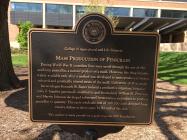Inscription
College of Agricultural and Life Sciences
During World War II countless lives were saved through the use of the antibiotic penicillin, a natural product of a mold. However, the drug became widely available only after a method was developed to mass-produce it from a selected and genetically altered strain of the mold. University of Wisconsin bacteriologist Kenneth B. Raper isolated a productive organism, botanist John F. Stauffer genetically modified it, and biochemists William H. Peterson and Marvin Johnson developed submerged fermentation techniques to produce penicillin in quantity. The early wholesale cost of 100,000 units dropped from twenty dollars to three cents by the end of the war.Details
| HM Number | HMLR9 |
|---|---|
| Series | This marker is part of the University of Wisconsin series |
| Tags | |
| Year Placed | 2001 |
| Placed By | UW Foundation |
| Marker Condition |           0 out of 10 (1 reports) |
| Date Added | Tuesday, September 9th, 2014 at 12:43am PDT -07:00 |
Pictures
Photo Credits: [1] HAMILTONES
Locationbig map
| UTM (WGS84 Datum) | 16T E 303605 N 4772003 |
|---|---|
| Decimal Degrees | 43.07531667, -89.41240000 |
| Degrees and Decimal Minutes | N 43° 4.519', W 89° 24.744' |
| Degrees, Minutes and Seconds | 43° 4' 31.14" N, 89° 24' 44.64" W |
| Driving Directions | Google Maps |
| Area Code(s) | 608 |
| Closest Postal Address | At or near 1302 4th St SW, Madison WI 53706, US |
| Alternative Maps | Google Maps, MapQuest, Bing Maps, Yahoo Maps, MSR Maps, OpenCycleMap, MyTopo Maps, OpenStreetMap |
Is this marker missing? Are the coordinates wrong? Do you have additional information that you would like to share with us? If so, check in.
Nearby Markersshow on map
Maintenance Issues
- What historical period does the marker represent?
- What historical place does the marker represent?
- What type of marker is it?
- What class is the marker?
- What style is the marker?
- Does the marker have a number?
- This marker could use another picture or two.
- Can this marker be seen from the road?
- Is the marker in the median?

Comments 0 comments